
 |
Particle accelerators were invented to investigate objects with size less then 10-12 cm. Accelerators are to particle physics what telescopes are to astronomy, or microscopes are to biology. These instruments all reveal and illuminate worlds that would otherwise remain hidden from our view. They are the indispensable tools of scientific progress. The earliest accelerators were simple vacuum tubes in which electrons were accelerated by the voltage difference between two oppositely charged electrodes. From these evolved the Cockcroft-Walton and van de Graaff machines (Figure 01), larger and more elaborate, but using the same principle. The modern example of this type of device is the linear accelerator, a sophisticated machine used in many scientific and medical applications. All such straight- |
Figure 01 Van de Graaff Generator [view large image] |
line accelerators suffer from the disadvantage that the finite length of flight path limits the particle energies that can be achieved. |
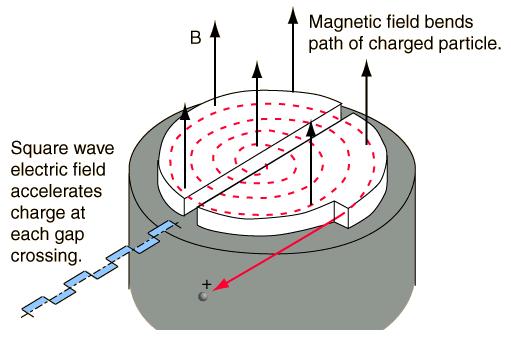 |
 |
The great breakthrough in accelerator technology came in 1920 with Ernest O. Lawrence’s invention of the cyclotron (Figure 02). In the cyclotron, magnets guide the particles along a spiral path, allowing a single electric field to apply many cycles of acceleration. Soon unprecedented energies were achieved, and the steady improvement of Lawrence’s simple machine has led to today’s proton synchrotrons (PS, Figure 03), whose endless circular flight paths allow protons |
Figure 02 Cyclotron |
Figure 03 Synchro- tron [view large image] |
to gain huge energies by passing millions of times through the electric fields that accelerate them. |
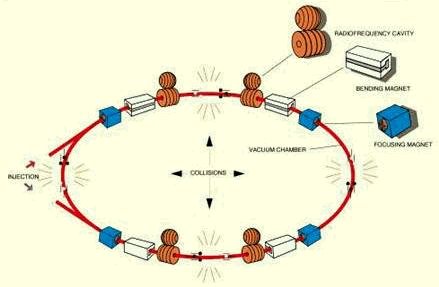 |
Until twenty-five years ago, all accelerators were so-called fixed-target machines, in which the speeding particle beam was made to hit a stationary target of some chosen substance. But early in the 1960’s physicists had gained enough experience in accelerator technology to be able to build colliders, in which two carefully controlled beams are made to collide with each other at a chosen point (Figure 04). Several colliders exist around the world today, and the technology for them is by now well established. Colliders are more demanding to build, but the effort pays off handsomely. In a fixed-target machine, most of the projectile particles continue the forward motion |
Figure 04 Collider |
with the debris after impact on the target. In a collider, on the other hand, two particles of equal energy coming together have no net motion, and collision makes all their energy available for new reactions and the creation of new particles. |
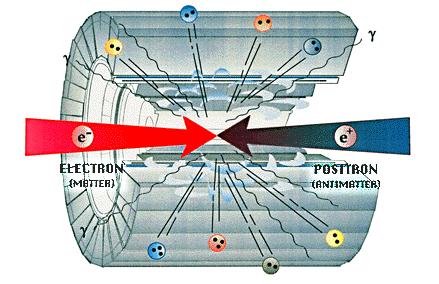 |
It is realized that the mass-energy relation (E = mc2) provides a new way to get information about particles. If particles could be made very energetic and then used to collide with other particles, some of their energy could be converted into the creation of previously unknown particles. When particles are produced in a collision, they are not particles that were somehow inside the colliding ones. They are really produced by converting the collision energy into mass, the mass of other particles (Figure 05). Which particles will be produced is partly determined by their mass - the lighter they are, the easier it is to |
Figure 05 High Energy Collision [view large image] |
produced them, other things being equal - and also by the probabilities calculated from the Feynman diagrams. |
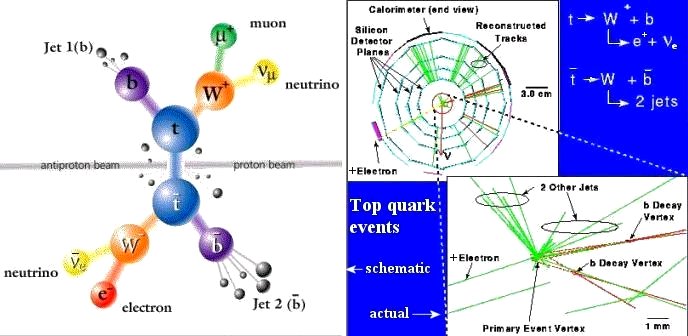 |
Particle with energy about 1 Gev (109 ev) is required to probe the structure inside proton. Higher energy is required for smaller system - about 1000 Gev is needed to probe into the quarks. The same amount of energy is required to create many of the hypothetical particles. Currently, the Fermilab's Tevatron has enough energy to produce the top quark (~170 Gev). Figure 06 shows a schematic diagram of a top quark event and the actual observation. Since there is no free quark, the result is a jet of hadrons (particles affected by |
Figure 06 Top Quark Events [view large image] |
strong interaction) emerging in the direction of the original quarks. Up to 14 Tev (1012 ev) will be available by the LHC at CERN in 2007. Table 01 below summarizes some features of the major accelerators in the world (all of them are colliders): |
| Accelerator | Colliding Particles | Total Energy | Major Accomplishment |
|---|---|---|---|
| Stanford Linear Collider (SLC) in Palo Alto | electron, positron | 100 Gev | provided first look at Z0 |
| Large Electron Positron Collider (CERN-LEP) in Geneva |
electron, positron | 200 Gev | discovered Z0, W+ - in 1983; shut down in 2002 |
| Relativistic Heavy Ion Collider (BNL-RHIC) in Brookhaven |
heavy ions | 200 Gev | created quark-gluon plasma (little Big Bang) |
| Tevatron (FNAL) in Chicago | proton, antiproton | 2 Tev | confirmed Z0, W+ -, discovered top quark |
| Large Hadron Collider (CERN-LHC) in Geneva |
proton-proton; ion-ion | 14 Tev | planned for 2007 - LEP replacement |
 |
The detection of high-energy particle or photon started with its darkening effect on photographic plates. Other methods for detecting radiation were soon developed, including scintillation techniques, electroscopes and the Geiger counters. Then a great breakthrough came in 1912 when the cloud chamber was invented. This device induces visible water droplets to form around the atoms, which have been ionized by the passage of the radiation through air. This provides a plan view of the path of the radiation and so gives a clear picture of what is happening. Figure 07 shows the three components of the cloud chamber - the radioactive source, the chamber, and the magnetic field, which is perpendicular to, and out of the plane of the picture. The magnetic field B, the velocity v, the radius of the |
Figure 07 Cloud Chamber [view large image] |
circular orbit R, the mass m, and the charge q are related by the formula: R = mv / Bq. If the direction of the initial velocity is not perpendicular to the field, the charged particle will move in a helix. |
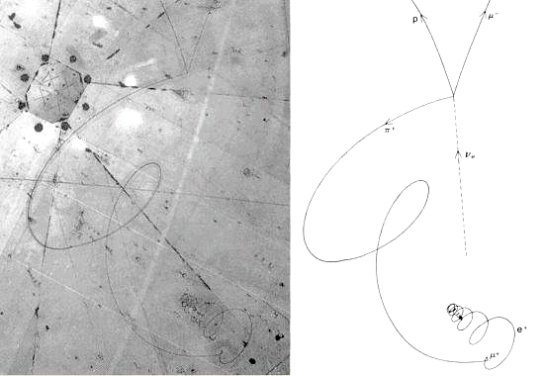 |
The bubble chamber used in high-energy accelerator experiments is the sophisticated variants of the cloud chamber. It is normally made by filling a large cylinder with a liquid just below its boiling point; at the top of the chamber a camera looks in. The whole chamber is subject to a constant magnetic field. As the particles enter the chamber, a piston suddenly decreases the pressure in the chamber. This brings the liquid to a superheated state, in which a tiny effect, such as the passing of a charged particle near an atom, is sufficient to nucleate a bubble of vaporized liquid. At this moment, the camera records the picture. Figure 08 shows the tracks of the charged particles in the |
Figure 08 Bubble Chamber [view large image] |
electroweak process   + p => + p =>  - + p + - + p +  + and the subsequent decay of + and the subsequent decay of  + to + to  +, and to e+. Since +, and to e+. Since   is a neutral particle. Although it is shown as a dotted line in the map, it leaves no track in the bubble chamber photograph. is a neutral particle. Although it is shown as a dotted line in the map, it leaves no track in the bubble chamber photograph. |
 |
Geiger counter, a particle leaves a trace of ions and electrons, which drift toward the case or the nearest wire, respectively. By marking off the wires which had a pulse of current, one can see the particle's path. Several planes of wires with different orientations are used to determine the position of the particle very accurately. With the multiwire chamber the data handling capacity increased dramatically. If one also precisely measures the timing of the current pulses of the wire and take into account that the ions need some time to drift to the nearest wire, one can infer the distance at which the |
Figure 15-02c Drift Chamber |
particle passed the wire. This greatly increases the accuracy of the path reconstruction and is known as a drift chamber (Figaure 09). |
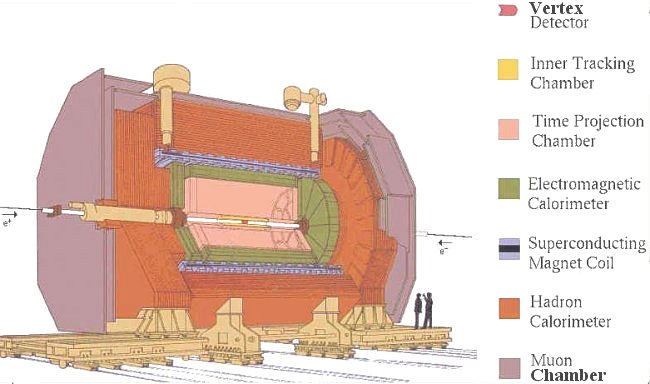 |
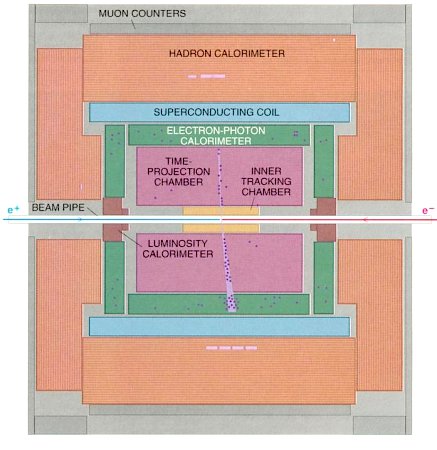 |
|
Figure 10 ALEPH Detector |
Figure 11 Side-view [view large image] |
electrodes on the surfaces. This charge cloud induces an electrical pulse on metal strips on the surfaces. |
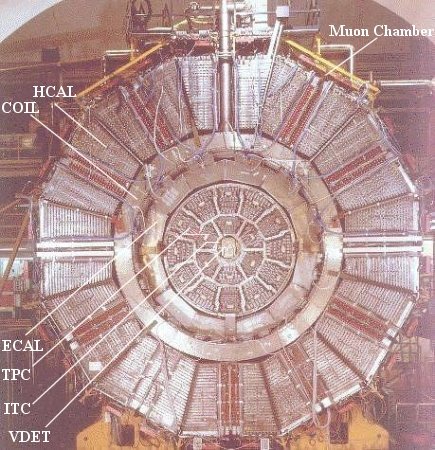 |
 |
|
Figure 12 Cap End |
Figure 13 ALEPH Event [view large image] |